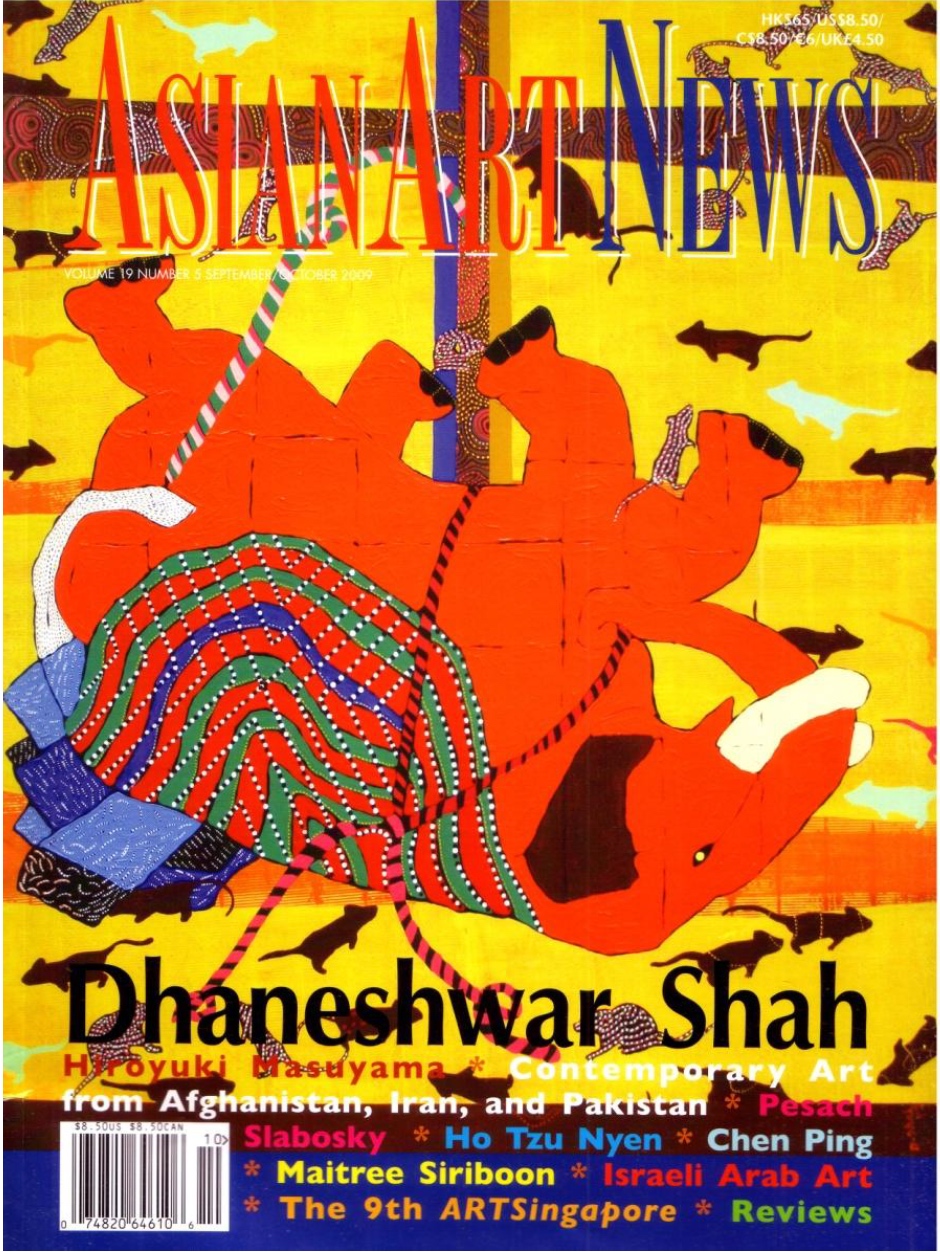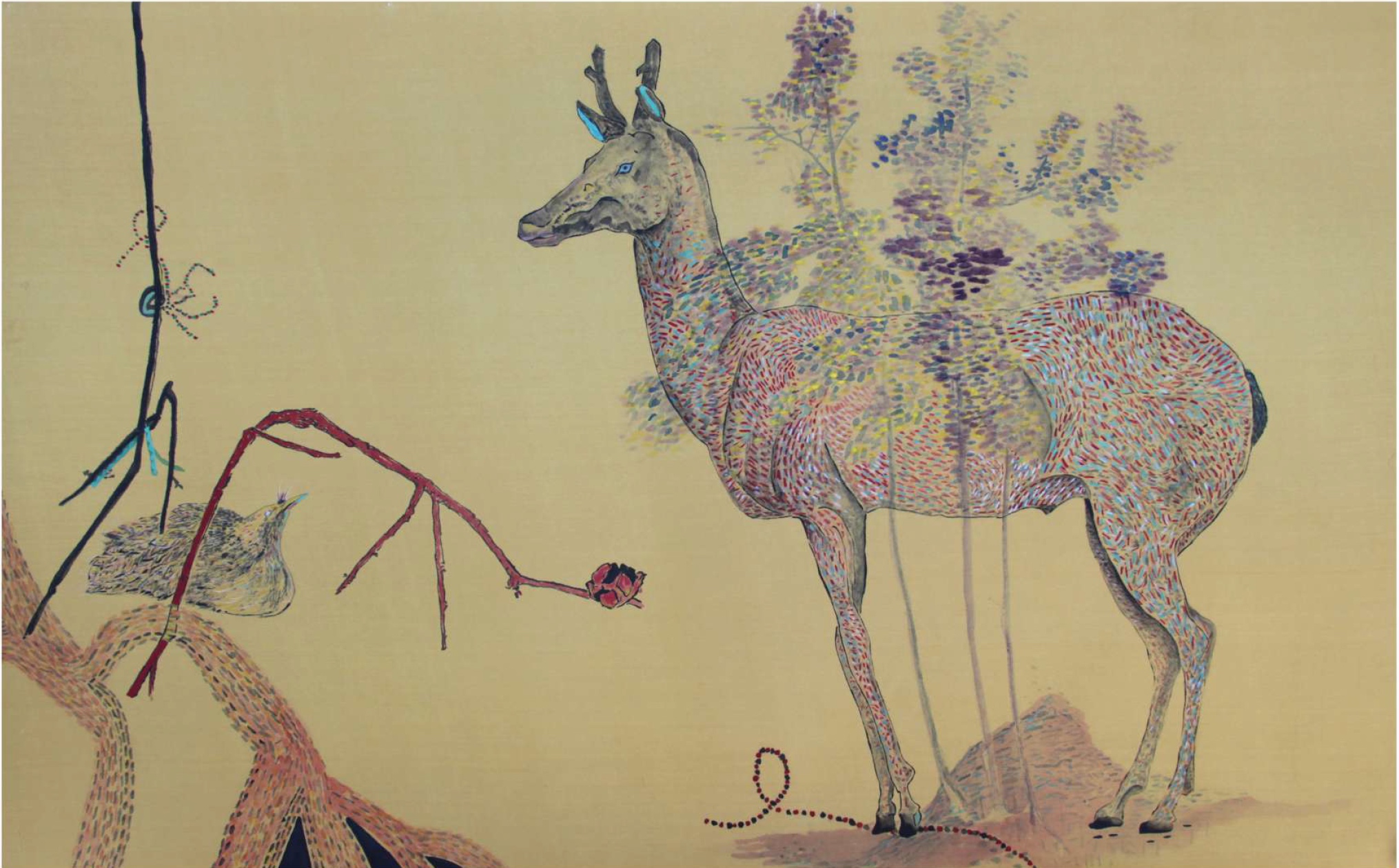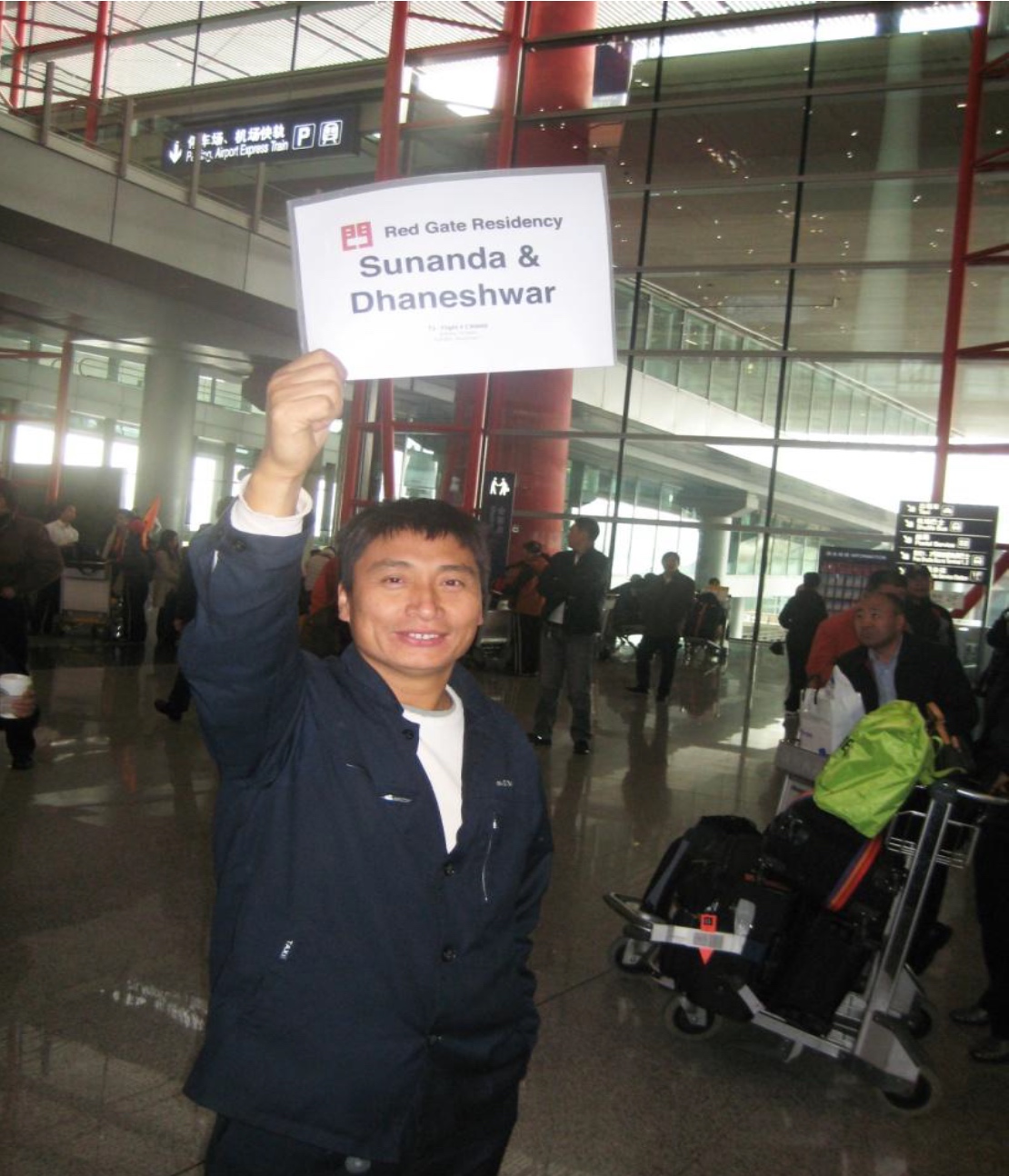
Dog Finding a Tree, Acrylic on Canvas, 2018, Dhaneshwar Shah
China Residencies: Hi Shou Tian! Thank you so much for reaching out, we always love hearing from artists who have a long history with artist residencies in China. Are you still in the midst of pursuing a PhD at the Wuhan University of Technology?
Dhaneshwar Shah: Hello, it’s also a pleasure talking to you. People do refer to me as the "Wuhan-based artist," you can call me by my Chinese name, Shou Tian 寿天 - it also gives me a new identity. Currently, I am pursuing a Doctoral study in Wuhan and also am teaching part-time as a visiting faculty, which was facilitated by the Chinese and Indian governments. My research is guided by Dong Jining, the Dean, Professor of the Wuhan University of Technology and Hubei Academy of Fine Arts, director of the Chinese painting art committee and member of the Chinese artists association, and the College of International Cultural Exchange (CICE). The doctoral research primarily focuses on the various genres of Chinese contemporary art.
CR: Can you tell us a little bit about your background?
DS: My name is Dhaneshwar Shah. I am of Indian nationality, and work as a visual artist practicing around the world. I completed my BFA and MFA in my home city of New Delhi. Afterwards, I studied traditional Chinese ink art and mix media art at the China Academy of Art in Hangzhou. I also participated in many conferences, exhibitions, residencies, workshops, and festivals across China, including Hubei, Suzhou, Shanghai, Sichuan, Shanxi, Beijing, Nanjing, Hohot, and Hangzhou. I also received numerous fellowships, grants, and residencies at Huan Tie Art Museum, Red Gate Art Residency, Civitella Ranieri Art Residency, Bundanon Art Residency, and also a travel grant from the Danish government. I travel widely for my work and creative inspiration and artistic practices all around the world. In this way, I consider myself a global citizen.
My artworks are strongly influenced by tribal and aboriginal art and its philosophy, technique, and form, which I believe to be pure and entirely authentic. These influences can be seen in my artworks through a combination of dotted lines, thick outlines, bright and flat colors, humor, repetition of forms forging a distinct in language and techniques. Animals have occupied a very permanent place in my artwork for a long time. I mostly use the animal form as a vehicle for my narrative which is focusing on the many issues pertaining to it, with animals fighting for their lives around the world. Used of various mediums and experimentation in artwork, my personal desire is to establish new sense, language, possibilities, and aspects of contemporary art.

Ink on Paper by Dhaneshwar Shah

What are the characteristics of Chinese painting? Shou Tian (right) is learning Chinese ink painting from Professor Dong Jining (left)
CR: You also curated an event about the Belt & Road Initiative, the “New Chapter: One Belt and One Road International Art Exchange Festival at Dong Jining Art Museum, Xianning, Hubei“. What was the festival about?
DS: Last year, on the occasion of The 70th Anniversary of The Founding of the People's Republic of China " New Chapter: One Belt and One Road International Art Exchange Festival curated by me, at Dong Jining Art Museum, Xianning, Hubei. For me, it was an extremely great experience and honor to curate this event. Actually, this responsibility and opportunity was provided by the professor and artist Dong Jining. We invited approximately 60 national and international artists from various countries such as Australia, South Korea, Italy, USA, France, Indonesia, Turkey, Russia, Japan. The learning and sharing process is inevitable, these things belong together just as we need the air to breathe in and out.
China Residencies: For how long have you been living in Wuhan now? How has campus life been so far? And how has life in the city been before the outbreak happened in January?
Shou Tian: I’ve only been here for the past five years and I love this city a lot. Wuhan, the capital of Hubei province, it kind of functions as the political, economic, financial, cultural, educational, and logistical center for central China. Wuhan is the third-largest education and scientific base in China and some say it has the largest number of research scholars in China. Fortunately, the Wuhan University of Technology offered me an opportunity for a doctoral study and to work on my art practice. When I started the PhD, the university provided me an accommodation, monthly grants, a studio space, and other facilities inside and outside of the campus.
Living on campus is completely different from any other experience I ever had. I’ve had a possibility to explore multicultural experiences, meet people from different parts of the world, culture, religion, and traditions. It also means that I am much closer to my fellows than someone who lives off-campus in an apartment. For me, academic life is imperfect if you don't live on campus.
As for the city itself, Wuhan is an incredible city with a vibrant culture, delicious food, and it is full of history. There is also a lot of nature in the city. What I find especially interesting is the century-old buildings of Hankou, which bears witness to the growing prosperity of that time. Getting a rich breakfast of 热干面 (Re Gan Mian / spicy dry noodles) together with friends is an excellent way to spend the morning. Sometimes our Chinese artist friends, curators, and or gallerists invite us for a Chinese tea ceremony.
I hope that once the most of the coronavirus pandemic passes, there will be a chance for life to become regular again.

Social Community Project during the Shanxi Art Festival and XuCun Art Residency

"Making a Friendship Tree" with Master of Future during the YCIS Art Residency, China

Exploring the Chinese Culture during the Shanxi Art Festival and XuCun Art Residency
China Residencies: When we first started talking on WeChat, you told me that you haven’t been in the city since the beginning of this year. When exactly did you leave the city, and what was it like to evacuate Wuhan during an epidemic? Where are you based at the moment?
Shou Tian: Though Wuhan has numerous diverse identities, nowadays, it is sadly known as the Chinese city from where the coronavirus pandemic began its deadly spread to all corners of the world. Confirmed cases of the virus have been reported everywhere and thousand people have succumbed to the virus, in China and in other countries. The Chinese government implemented a series of large-scale interventions to control the epidemic. The strictest control measures were applied in Wuhan with a complete lockdown for the whole population. It began on January 23rd 2020, when Wuhan city officials stopped all transport in and out of the city. But in this critical situation our university provided us with all the necessities, day and night. During the pandemic, I originally decided to stay on campus because of the academic and professional work pressure, and I also did not want to leave my many friends from different nationalities.
Unfortunately, the situation was more severe than initially assumed, and the World Health Organization announced a global emergency. So on January 31st, the Indian government decided to evacuate all Indian citizens from the Wuhan. Finally, with the help of the Indian Government, the Chinese Government, and the University I arrived safely in New Delhi, India. I spent 20 days in quarantine at an Army hospital, we all tested for the virus and happily we were all tested negative. After this quarantine period, I returned to my home in New Delhi.

After the evacuation from Wuhan. Shou Tian at the quarantine Center in New Delhi, India
China Residencies: Do you have plans to return to Wuhan? If so, how do you think it’ll look like?
Shou Tian: Yes, of course, now Wuhan is like my second home and many of my friends are like my family members, and they are all waiting for me. I would like to go back to Wuhan immediately but now it is not possible because restrictions on the travel and present condition do not allow us to move anywhere. But I hope as time goes on, the pandemic situation will slowly get better. When international flight operates once again, I will travel to Wuhan straight away. This is a global medical emergency is caused by a virus we still do not fully understand. Our lifestyle, thinking, social relationships, and way of working have been completely changed by the impact of the pandemic. We still need to follow all medical instructions to control the spread of the coronavirus. Besides, I know we personally need to find solutions for how we can expand the creative art industries.

Under the Sky series, Dhaneshwar Shah
China Residencies: So, you’ve had quite a long history of working in China. What made you want to go in the first place?
Shou Tian: The very first artist residency I did in China was the Red Gate Residency in Beijing. I went there in 2009, motivated by the fact that I would be the first Indian artist at Red Gate, which was founded by the Australian Brian Wallace. The residency provided me with an opportunity to live and work in a studio in Beijing, and the people there helped me to connect with the Chinese contemporary art scene, local Chinese artists, and of course art galleries.
I have found out that artist residency programs give artists the opportunity to live and work outside of their usual studio environments, discover and create work also allows an artist to devote their entire time and energy to further their practice. My experience with the Red Gate Residency went above and beyond my expectations. My experience at this residency was different from any creative opportunity I’ve experienced, and personally speaking, it changed me a lot. Honestly, I can say in terms of facilities and support, this residency was the most amazing. I cannot forget Crystal Ruth Bell, she was a very energetic and charming residency director, she always took care of all artists. We will never forget her, she will be always in our thoughts and may her soul rest in peace.


The artist with photographer friends, Sunanda Khajuria and Wu Regan during his studio exhibition at the Huan Tie Art Museum in Beijing, China


Exhibition and Presentation at the Shangyuan Art Residency in Beijing, China
China Residencies: Do you have any fun stories to tell from you past residencies and travels through China which have been stuck in your memory?
Shou Tian: Yes, I have a lot of enjoyable stories about my time in China!
An encounter which I will always remember is a story about a Chinese art collector, who is a documentary filmmaker, and my Nokia 1100 cell phone. In summer 2015, I was working in the studio at Shangyuan Art Residency, and then one collector unexpectedly visited me. After a long conversation, he asked about my Chinese cell phone number. At that time I was temporarily using a Nokia 1100 in China, this was a very old and low-cost model, which was released in late 2003. When I brought this cell phone, this art collector started to laugh. He took me outside of the studio, went to his BMW car, opened the door of the car for me, and said: "Can you guess what you’ll see there?" He then showed me his Nokia 1100, he also loved to use the same old phone. Now, again, we both started to laugh at each other.
In 2009, Asian Art News covered my main interview and also printed my painting on the front page of the magazine. “Asian Art News" is one of the well-known international art magazines which is published in Hong Kong. On the second day at Red Gate, I decided to visit Brian Wallace at the Red Gate Gallery, which is located somewhere in the historic Southeast Corner Tower at Dongbianmen. During my conversation with Brian, one staff member gifted me the same issue of the art magazine which had my interview. The staff member had no idea about these things then Brian told him the artwork on the cover page belongs to me.
The last story is about my time at the academic art residency YCIS in Beijing. In 2018, I was invited for an artist residency for a month. I was taking a workshop with one artist and teacher, her name is Allison. During the workshop, we were explaining to the students about the significance of mixed media and collage, suddenly, unconsciously I took out a magazine from the trash of the room for demonstration. At the time we were all surprised because by chance I found my one of interviews inside the same magazine page, which was about my exhibition during my residency at the Huantie Art Museum in 2012.
So yes, in reality my life is full of various fascinating stories and every day happens something unique. So yes, I am enjoying my life and creativity in China.



(from left to right:) Nokia 1100 - Asian Art News with "Elephant with Rates" on the front cover - "Big Surprise" - one of Shou Tian's interviews inside the magazine during the artist residency at YCIS in Beijing, China
China Residencies: So, with you being in New Delhi and travel plans halted for a while, how do your plans for the upcoming months look like?
Shou Tian: First, I need to finish previous commitments, as you know due to COVID our life, work, and even the work methods are totally changed. Various essential works are postponed such as academic research, exhibitions, and additional art activities. Nowadays I am participating in a Geumgang Nature Art Biennale (South Korea), International Art Exhibition, Ningbo Art Museum (China), and Indian Contemporary Art Exhibition, Kunstetagerne Hobro (Denmark) , also writing a book on the impact of Covid19 on art and artists. This book will be published by a European publisher. For the short term, I am planning to head back to China for my upcoming solo exhibition with a local art museum and gallery in Shanghai and Wuhan as well as other countries.

Under the Sky series, Dhaneshwar Shah

Under the Sky series, Dhaneshwar Shah

Under the Sky series, Dhaneshwar Shah

Indian artist Shou Tian (left), Sunanda Khjauria (middle) and Brian Wallace (right), Founder of the Red Gate Art Residency and Art Gallery

"The first day in China" Upon arrival at the Beijing Capital International Airport, China

“New Chapter: One Belt and One Road International Art Exchange Festival at Dong Jining Art Museum, Xianning, Hubei“
This interview was conducted in English by Xiaoyao Xu for China Residencies in October 2020.
With the current pandemic and the ongoing travel restrictions worldwide, people have been finding ways to keep in touch with artists and friends online, since they can't meet up in person. In lieu of our annual research trip, we are revisiting spaces we've met in the past seven years through in depth interviews over WeChat until we can meet again.
All photos courtesy of Dhaneshwar Shah, 2020.
